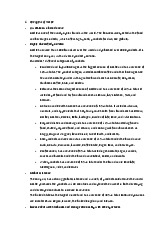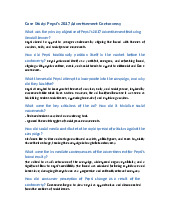




Preview text:
lOMoARcPSD|364 906 32
1. Strengths of Nestle -
A well-known brand name
Nestle is one of the most popular brands in the world. The business is respected in the food
and beverages industry, which offers high-quality products for daily use globally. -
Highly diversified portfolio
Nestle has more than 2000 brands all over the world and published over 8000 products. It is
the largest company with a diverse product portfolio.
It includes 7 different categories of products:
+ Powdered and Liquid Beverages is the biggest section of Nestle and has a revenue of
28% in total. The product category includes soluble coffee and other beverages like
tea and chocolate powder with signature brands such as Nescafe, Nespresso,
Starbucks Coffee, Milo, and Nestea.
+ Petcare is the second largest section of Nestle and has a revenue of 18% in total. It
includes pet food and toy from brands such as Purina, Lily’s Kitchen, Tails, and Merrick.
+ Nutrition and Health Science has a revenue of 15% in total. It includes vitamins,
minerals, and supplements that help to improve health from brands such as Illuma,
Gerber, Nestum, Cerelac, Beba, Lactogen, Garden of Life, Pure, and Vital Proteins.
+ Prepared dishes and cooking aids has a revenue of 14% in total including frozen
food, chilled prepared food, and culinary and cooking aids from brands such as
Maggi, Original Waggner, Lean Cuisine, Sweet Earth, and Freshly.
+ Milk products and ice cream has a revenue of 12% in total under the brand name
Nido, Nesvita, Carnation, Lattiere, Coffee Mate, Hagen Dazs, and Movenpick.
+ Confectionery has a revenue of 9% in total including chocolate, sugar, candies,
snacks and biscuits under the brand name KitKat, Cailler, and Garoto.
+ Water products has a revenue of 5% in total under the brand name Pure Life,
S.Pellegrino, Vittel, and Perrier. - Global existence
The company has a strong global existence and a variety of products sold
all over the world. Nestle purchases the products in 186 countries and captures the market
in both developing and developed countries to increase its revenue.
The United States is the largest market and has a revenue of 30% in total. Followed positions
are Greater China Region, France, the United Kingdom, and Mexico. -
License deal with Starbucks and strong relationship with other partners Due to the license
deal with Starbucks, Nestle can expand its coffee globally. Also, the firm has good lOMoARcPSD|364 906 32
relationships with other powerful brands such as Colgate Palmolive, Coca-Cola, General Mills, and L’Oréal. -
Efficient R& D system
Nestle is the largest food and nutrition research organization because the business has 21
R&D centers to research and develop the capability with the aim of improving competitive
advantages. There are more than 5000 employees working in the R&D operations of Nestle.
In 2017, the firm invested approximately 1.72 billion Swiss Francs in R&D. -
Environmental sustainability practices
The business follows substantial standards, so, it put efforts into environment-friendly
practices and innovative initiatives in developing quality products. From that, Nestle can
optimize solutions to reduce producing waste, water usage, non-renewable energy usage, and packaging materials. -
Big distribution system
The business has a large and diversifies supply chain everywhere. It has applied local
distribution methods and focused on running the business productively in respective
countries. Also, it has strong relationships with external partners such as suppliers, retailers, vendors, and distributors.
2. Weaknesses of Nestle - Increasing prices
The price of its products has increased by 6.5% in a certain category because of an increase in
raw materials, delivery costs, supply chain constraints, and a general inflationary environment. -
A span of control and organizational structure
The business conducts a matrix structure that there are a lot of brands
being under the same group. It leads to challenges in managing individual brands, discord, and conflict of interest. - Social criticisms
Nestle has been the target attention of the media many times. There are many claims
including privatizing water, misleading labeling and using child and slave labor that has
become a weak point for its reputation in the market. -
Maggi Noodles controversy
Nestle tested a laboratory in India in 2017 and failed it. Although the business claimed that
there is no added MSG in the noodle packets, the results after testing 1000 times did not
change. Consequently, the business faced a decrease in sales (the loss of 80% market share) lOMoARcPSD|364 906 32
and a negative brand reputation. Also, the social criticisms do not only impact the local
market of Nestle but also on other markets. -
Racially insensitive product names
Nestle has been accused of using racism or insensitive names on its products. For example,
in Australia, the firm named its sweets Red Skins and Chicos which makes Nestle has been under pressure. - Unhealthy products
The business has a long list of unhealthy products such as the China Milk Scandal and tainted
cookie dough that makes consumers lose their belief in the company and its products.
3. Opportunities of Nestle -
Venturing small food start-up
It would be a great opportunity for Nestle to grow a large number of small food start-ups
under its popular brand name and access a variety of customer ranges. Also, the business
can collaborate with other new startups to promote its brand. - E-commerce markets
Having e-commerce sites and an online shopping platform is a remarkable opportunity for
the firm. Offering online services can make the shopping experience of consumers more
comfortable and convenient. Also, its products will easily meet the needs of potential global online customers.
Therefore, Nestle can expand its markets in different countries. -
Market penetration for breakfast cereals
After the social distancing because of COVID-19, more and more people focus on their
health. Breakfast cereals are the growing products of Nestle recently. Therefore, the
company should penetrate this market such as Maggie Oats, Milo cereal, or other relevant
products to attract more customers. -
Expanding tea and coffee market
The need for tea and coffee is continuously increasing and is a potential profit source for
Nestle to improve this market. For example, people can use Nestle’s tea or coffee pockets
when they are at work to enjoy themselves. - Partnerships
Having partner relationships with other food and beverage brands is a good opportunity for
the business to develop its revenue and profits. Nestle has partner relationships with Coca-
Cola and L’oreal that help it has many great opportunities. If the firm develops more lOMoARcPSD|364 906 32
partnerships, it can operate campaigns or discount, collab programs to attract and impress more markets and customers. - Authentic labeling
Although the company has been criticized for providing misleading nutritional information
on its product labels, it is an opportunity to improve and give trustworthy information,
especially related to nutrition. -
Develop bottled water and snack foods:
Snack foods and bottled water are suitable for a long trip or picnic. People tend to choose
them due to their convenience, cleaning, and different ways to use them. Thereby, Nestle
can develop the products to launch in this potential market. -
Develop prepackaged foods:
Because the busy with work or lazy about cooking, consumers tend to use prepackaged
food. To meet this demand, Nestle should develop this product category to become an
important role in people’s daily lives. -
A vegan substitute for Tuna
Nestle has developed healthier and plant-based food categories to focus on customers’
health and environment. Vuna is a futuristic food technology that the company is working on and claims to be.
4. Threats of Nestle -
Price fluctuations by big retailers
Several retailers such as Walmart, Tesco, Target, and Kroger have purchased Nestle’s
groceries. If there is any change in prices by these retailers, it can affect the business profitability. -
Illegal rainforest destruction controversy
In 2017, Nestle was involved in the illegal destruction of rainforests in Sumatra. It suffered
criticisms from NGOs and environmentalists. - Water scarcity
Due to the dependence on water usage, Nestle has faced accessing costly sources of clean
water, increasing population, climate change, increasing demand for food and water,
pollution, water waste, and overexploitation of resources. - Rising competition
There are many new CPG companies offering similar products. It makes Nestle has to face
competition in accessing substitute products. - Government regulations lOMoARcPSD|364 906 32
Government policies can affect Nestle’s operations. Moreover, the increasing prices of
materials lead to an increase in product prices. It will reduce sales and consumers can switch
to using other brands with lower costs. - Economic Uncertainty
Due to the panic buying catalyzed, the revenue of Nestle can be threatened by the
uncertainty and recession in the worldwide markets. - Dark Drawbacks
Some bad drawbacks can haunt the company and affect its sales, profitability, and growth
for years though these events happened many years ago. References:
Parker, Brianna. “Nestle SWOT Analysis 2022 | SWOT Analysis of Nestle.” Business Strategy Hub, 16
Jan. 2019, bstrategyhub.com/nestle-swot-analysis-2019-swotanalysis-of-
nestle/#SWOT_Analysis_of_Nestle.
Document Outline
- 1. Strengths of Nestle
- 2. Weaknesses of Nestle
- 3. Opportunities of Nestle
- 4. Threats of Nestle




